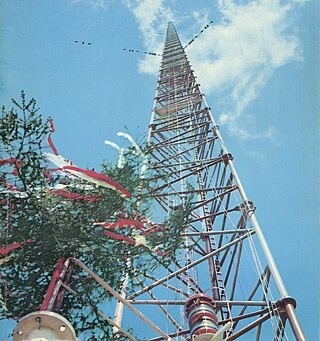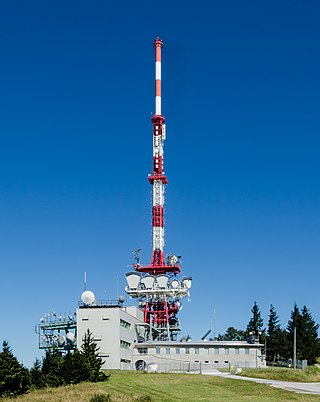
The Warsaw Radio Mast was a radio mast located near Gąbin, Poland, and was the world's tallest structure at 2,120 ft from 1974 until its collapse on 8 August 1991. The mast was designed for extreme height in order to broadcast Soviet propaganda around the world, including to the remotest areas such as Antarctica. As of 2023, it was the third-tallest manmade structure ever built, after the Burj Khalifa tower in the United Arab Emirates in 2009, and Merdeka 118 tower in Malaysia in 2022.

The Hellissandur longwave radio mast is a 412 m (1,352 ft) tall guyed radio mast used for longwave radio transmissions of RÚV. It is situated at Gufuskálar, near Hellissandur on the Snæfellsnes peninsula of West Iceland. It is currently the tallest longwave radio mast in the world and the tallest above ground structure in Western Europe.

Sender Zehlendorf or Zehlendorf (radio) transmission facility was a radio transmission facility which was in service since 1936, when a short wave transmitter was built on the occasion of the Berlin 1936 Summer Olympics in Zehlendorf as part of the establishment of permanent radio services. This Zehlendorf site, which until the end of World War II was referred to as the Rehmate Radio Transmission Centre, had 26 different antennas at the time.

The longwave transmitter Raszyn is a longwave broadcasting transmitter near Raszyn, Poland. It was built in 1931 and rebuilt in 1949. The designer of the mast is unknown. It has been claimed that the rebuilt tower consists of sections from the radio mast of former Deutschlandsender Herzberg/Elster; however, there is no proof of this theory. The mast of the Raszyn longwave transmitter was, at inauguration, the second-tallest man-made structure on earth and until 1962, with a height of 335 metres, the tallest structure in Europe. The tower's height is 1,099 feet.

The Mühlacker Broadcasting Transmission Facility is a radio transmission facility near Mühlacker, Germany, first put into service on November 21, 1930. It uses two guyed steel tube masts as aerials and one guyed steel framework mast, which are insulated against ground. It has two transmission aerials for shortwave and one free standing steel framework tower for directional radio services. The shortwave transmitter was shut off on October 19, 2004. The medium wave transmitter was switched off in January 2012.

The Langenberg transmission tower is a broadcasting station for ananlog FM Radio and Digital-TV signals. It is located in Langenberg, Velbert, Germany and owned and operated by Westdeutscher Rundfunk, WDR.

The Transmitter Ismaning was a large radio transmitting station near Ismaning, Bavaria, Germany. It was inaugurated in 1932. From 1932 to 1934 this transmitter used a T-antenna as transmitting antenna, which was spun between two 115-metre-high free-standing wooden lattice towers, which were 240 metres apart. As this antenna had an unfavourable vertical radiation pattern, which produced much skywave resulting in a too small fading-free reception area at night, in 1934 a new antenna was installed. Therefore, one of the towers was dismantled and rebuilt on a 39-metre-high (128 ft) wooden lattice base. While this work took place, an L-Antenna was used, which was spun between the other tower and a small auxiliary wooden tower. It became defunct in 1977 and was destroyed in 1983.

The Königs Wusterhausen transmitter was a large transmission facility for longwave, mediumwave and shortwave radio, located near Königs Wusterhausen southeast of Berlin, Germany. Initially built by the telegraph battalion of the German Army, operation began during World War I in 1916. On 22 December 1920, the transmission of a Christmas concert marked the birth of public broadcasting in Germany.

The Peterborough transmitting station is a broadcasting and telecommunications facility at Morborne Hill, near Peterborough, England.

The Arfon transmitting station is a facility for FM, DAB digital radio and television transmission near the villages of Nebo and Nasareth in Gwynedd, northwestern Wales. It includes a 308.5 m (1,012 ft) guyed mast with antennas attached at various heights. The mast is surmounted by a television transmitting antenna, which brings the total height of the structure to 317.4 m (1,041 ft), making it the tallest structure in Wales. It is owned and operated by Arqiva.

Raichberg transmitter is a broadcast facility for various FM radio and television programs operated by the Südwestrundfunk on the Raichberg mountain in Albstadt, Baden-Württemberg, Germany. It uses a 137 meter (449 ft) guyed steel tube mast as the antenna tower. There is also a free-standing lattice tower for microwave radio.

Gaisberg Transmitter is a facility for FM and TV-transmission on the Gaisberg mountain near Salzburg, Austria. It was the first large transmitter in Austria finished after the war and started its work on 22 August 1956. It used a 73-metre-high (240 ft) lattice tower and broadcast Austria's first radio station on 99.0MHz and third radio station on 94.8 MHz, each with 50 kW, as well as a TV station on channel 8 with 60/12 kW (picture/sound). During the 1980s an UHF antenna was put on top of the tower, bringing its height to 100 meters.

The Tacolneston transmitting station is a facility for both analogue and digital VHF/FM radio and UHF television transmission near Tacolneston, 11 miles (18 km) south-west of Norwich, Norfolk, England.
The Kronstorf Transmitter was a mediumwave broadcasting facility near Kronstorf, Austria. Its construction started in 1950 by the American Forces occupying Austria, and went in service on 1952-03-01. The transmitter, used for broadcasting in Soviet-controlled Austria, consisted of one 274 m and two 137 m guyed masts.

The Strabane transmitting station is a broadcasting and telecommunications facility located at Legfordrum and situated very close to the town of Strabane, in County Tyrone, Northern Ireland. It is owned and operated by Arqiva.

The Kreuzberg is one of the Rhön Mountains in southern Germany. With about 928 m (3,045 ft) high it is the highest elevation of the Bavarian part of the Rhön, in the province of Lower Franconia. The Kreuzberg — also referred to as the "sacred mountain of the Franconians" — is near the town of Bischofsheim in der Rhön in the district Rhön-Grabfeld.

The Eiðar longwave transmitter was a facility previously used by RÚV for longwave radio broadcasting on 207 kHz with a power of 100 kW. The transmitter was situated at Eiðar near Egilsstaðir in East Iceland. It was demolished in March 2023. At the time of its closure, it used an omnidirectional aerial in the form of a 221-metre (725 ft) tall steel lattice mast radiator insulated against the ground. The transmission site was in use from 1938 until its closure in 2023.
Golm transmitter or Sender Golm was a medium wave broadcasting facility on the area of a former Reichsarbeitsdienst officer candidate school at Kuhforter Damm in Golm near Potsdam. It entered service in 1948 as the central broadcast transmitter for Brandenburg state. Until 1979 it used a wooden lattice tower of 98 m (322 ft) height with a horizontal wooden cross on its top as its antenna support. The ends of the beams of this cross were connected with wires. From the centre of each of these horizontal wires, a vertical wire was run down to the antenna tuner which was located in a building under the feet of the tower construction. The antenna of Golm transmitter consisted therefore of 4 T-antennas connected in parallel, forming an omnidirectional antenna with a natural wavelength of 528 m. The transmitter was built from second-hand parts obtained by dismantling a site in Reichenbach, Upper Lusatia. Test transmissions were undertaken on 16 April 1948, and from 1 May 1948 the facility operated on 564 kHz.

The Ochsenkopf Transmitter is a 163 metres (535 ft) radio and TV tower of reinforced concrete, which was built in 1958 on the summit of the 1,024 metres (3,360 ft) Ochsenkopf mountain, the second-highest mountain in the Fichtel Mountains in Northern Bavaria, Germany. The tower replaced a 50 metres (160 ft) guyed steel tube TV mast that collapsed in January 1958 as result of icing. The tower, which is not accessible to the public, has a hyperbolic-shaped basement with five floors for technical equipment. Above it, there are platforms for directional antennas. The antennas for FM-transmission are on the upper part of the concrete tower, those for TV transmission on a steel tube mast on the top.

The St Hilary transmitting station is a facility for telecommunications situated close to the village of St Hilary, Glamorgan in the Vale of Glamorgan, Wales, in the UK. It comprises a 229-metre (750 ft) guyed mast with antennas attached at various heights. The site was established in 1958 for Independent Television transmission on VHF. Transmissions from the site include FM radio, DAB radio and mobile telephone signals.




















